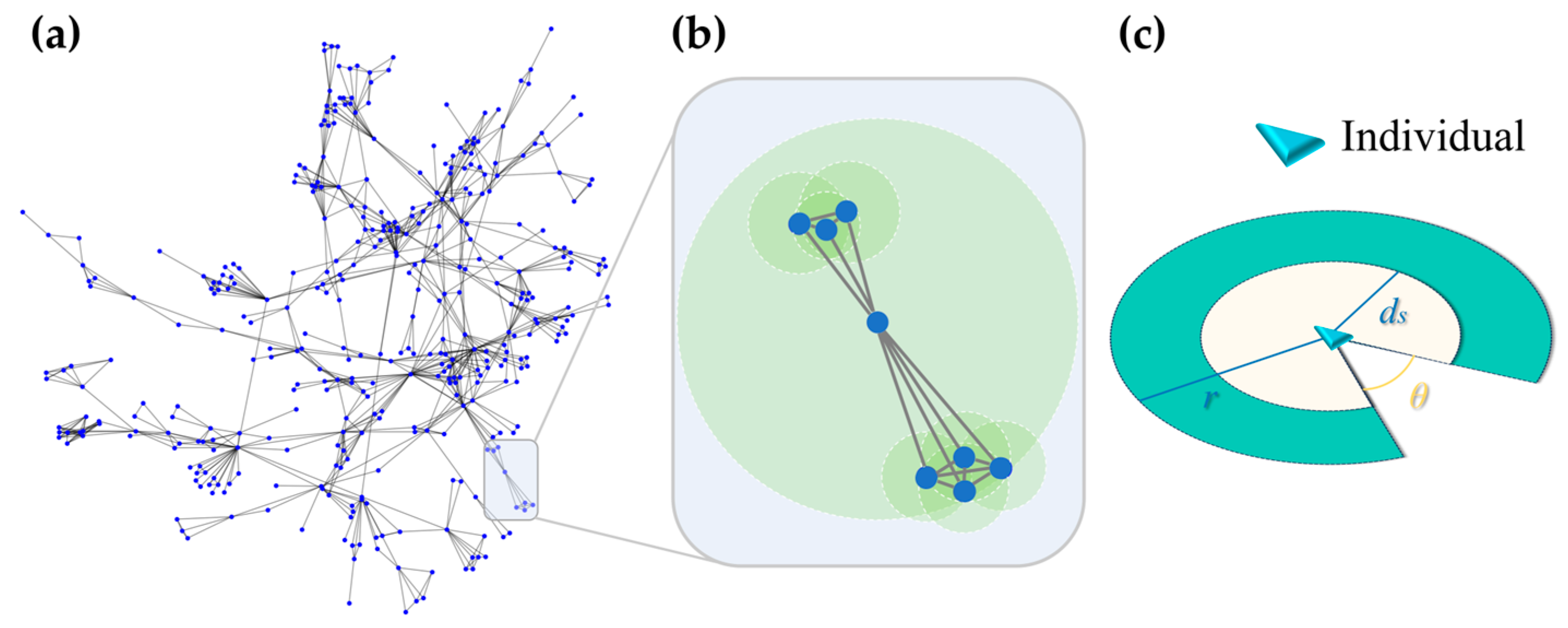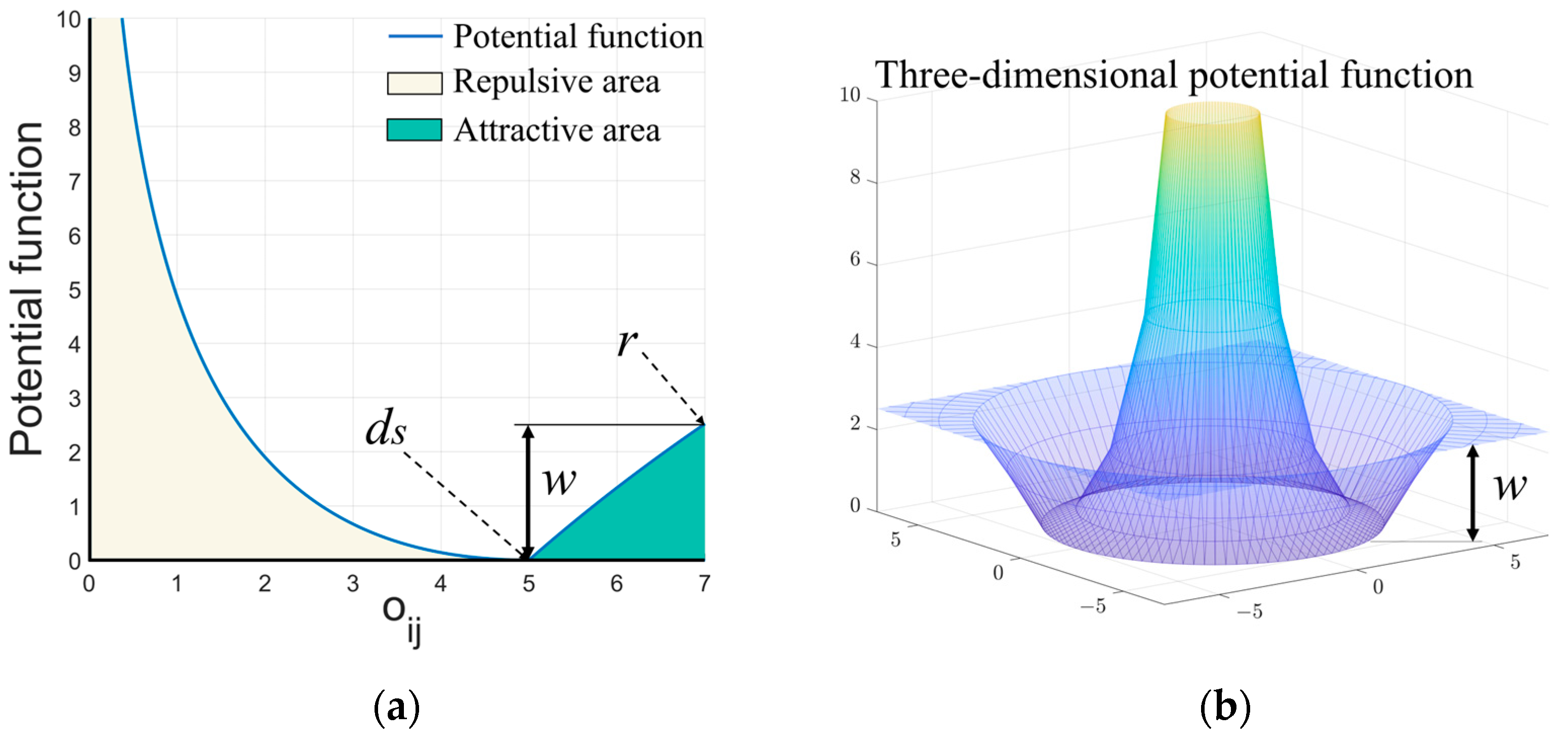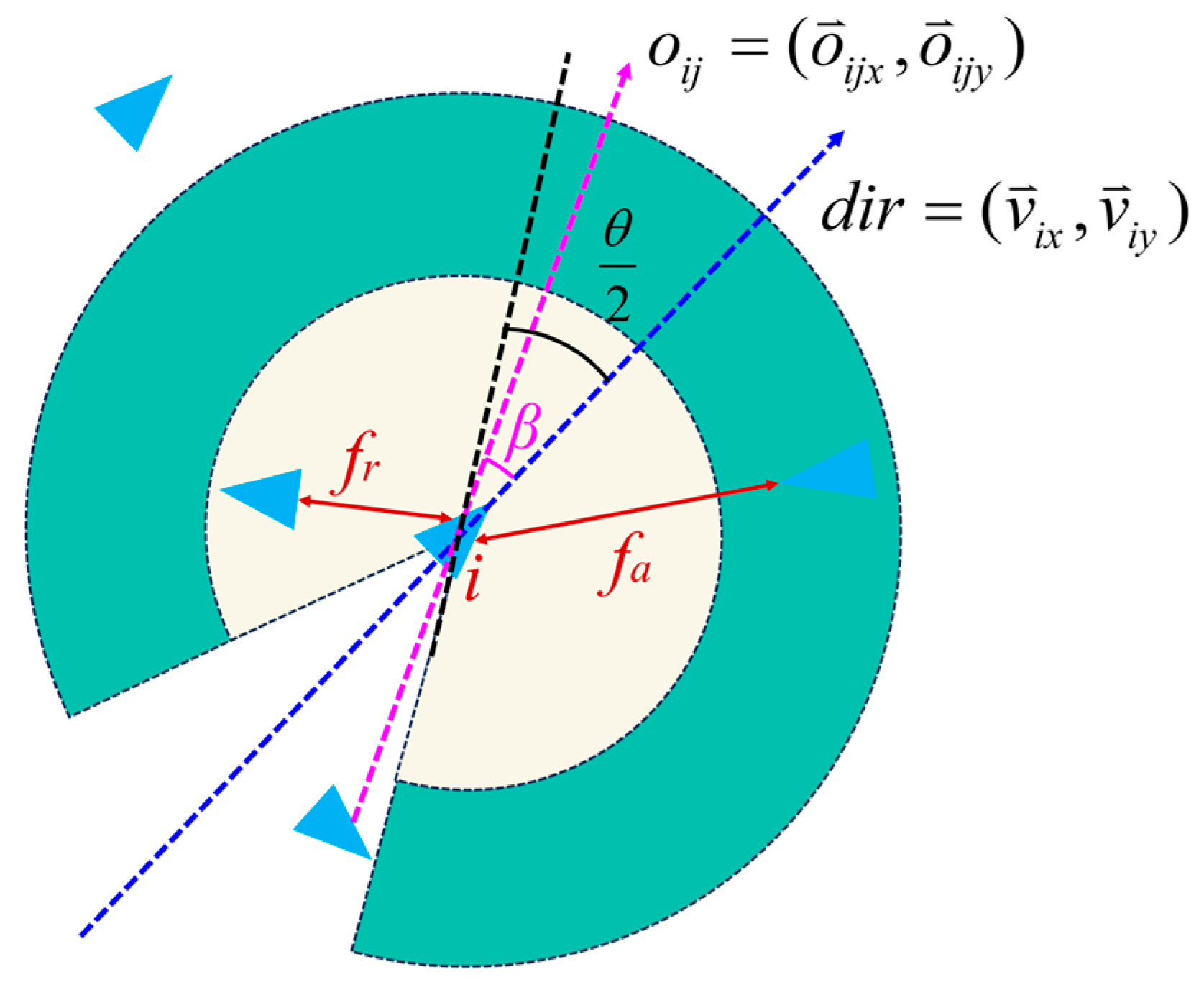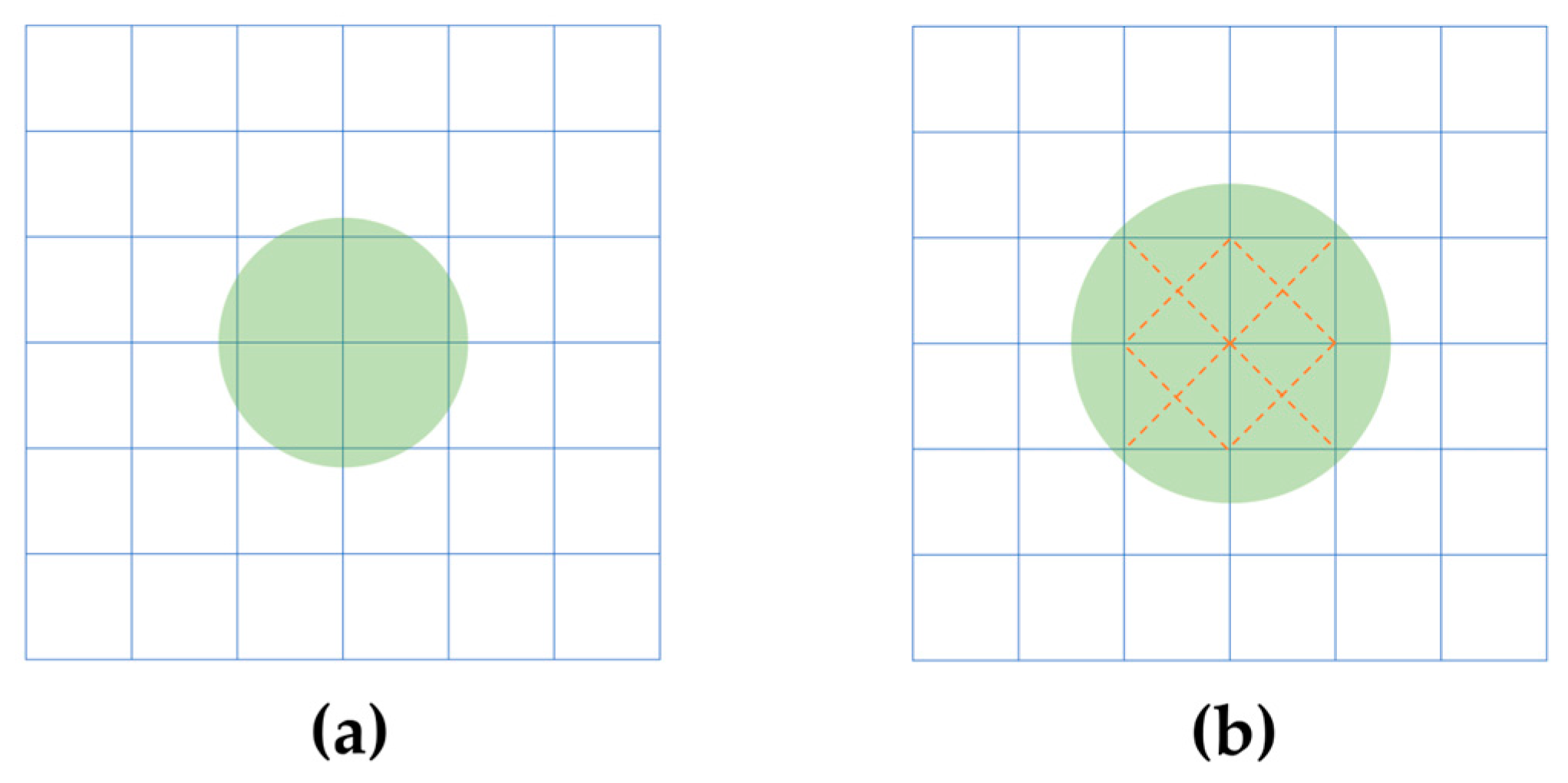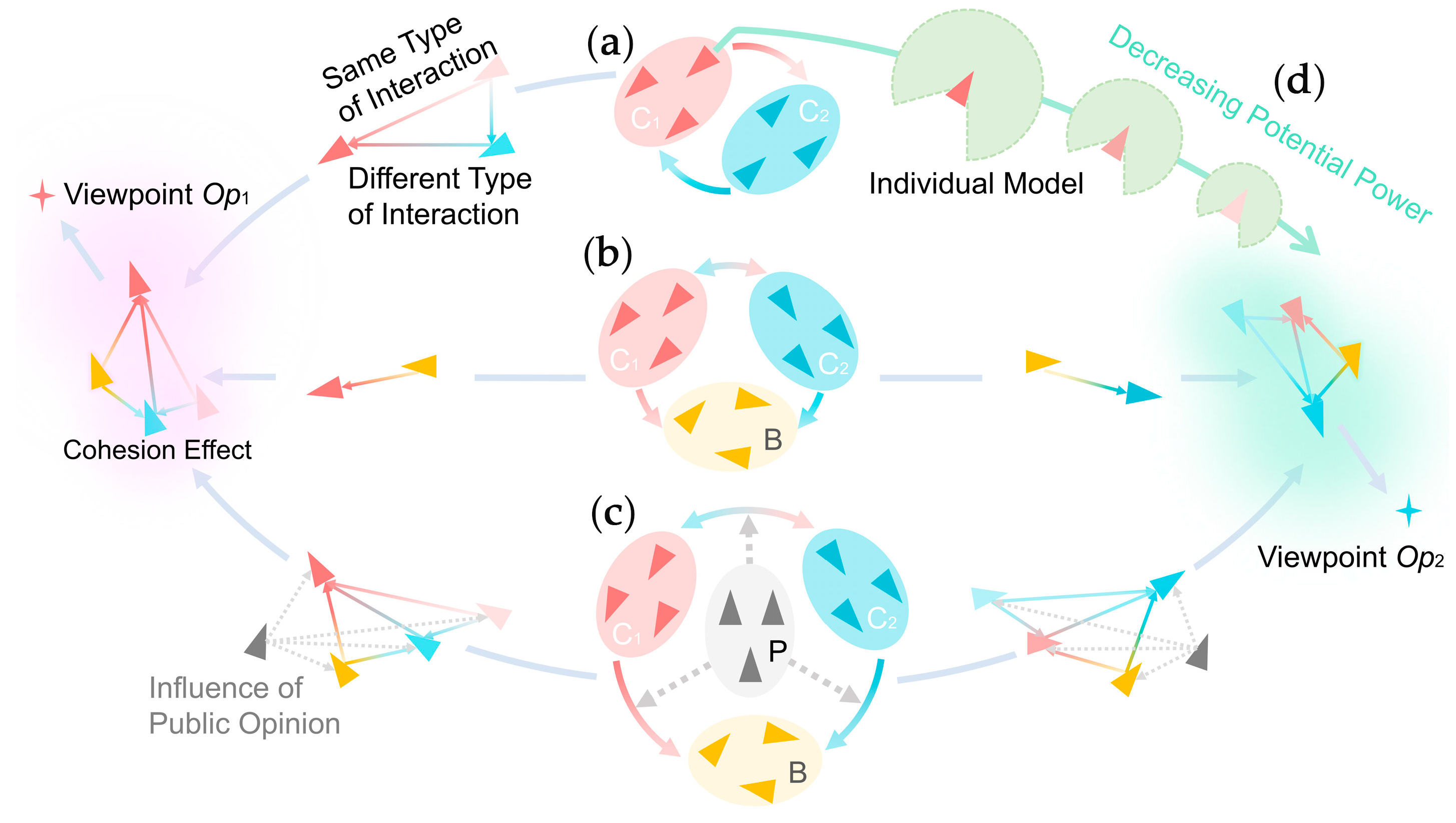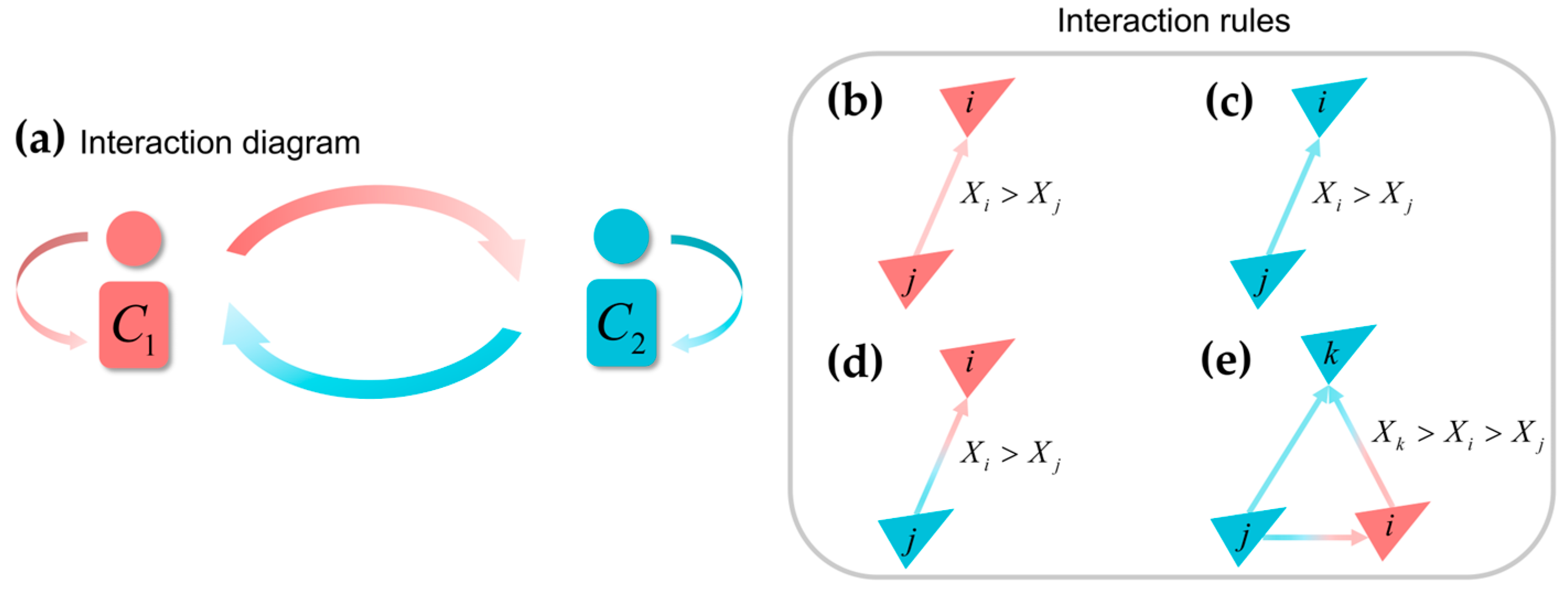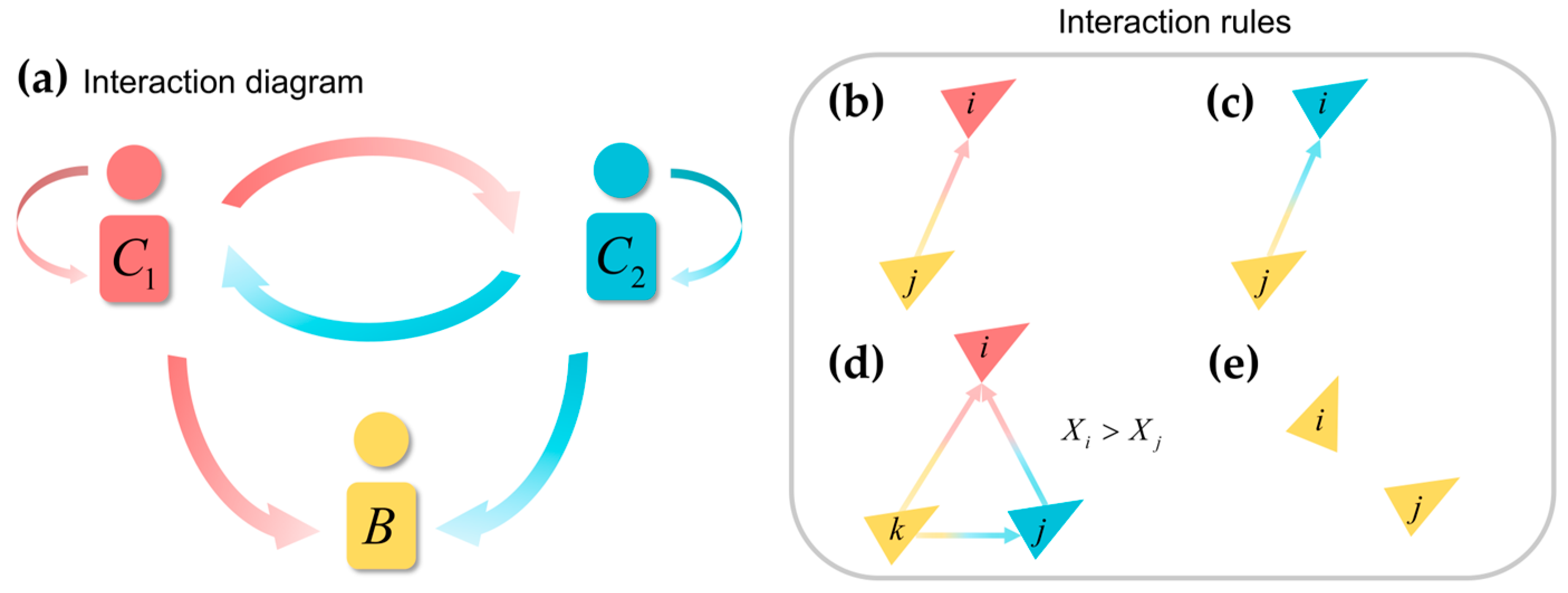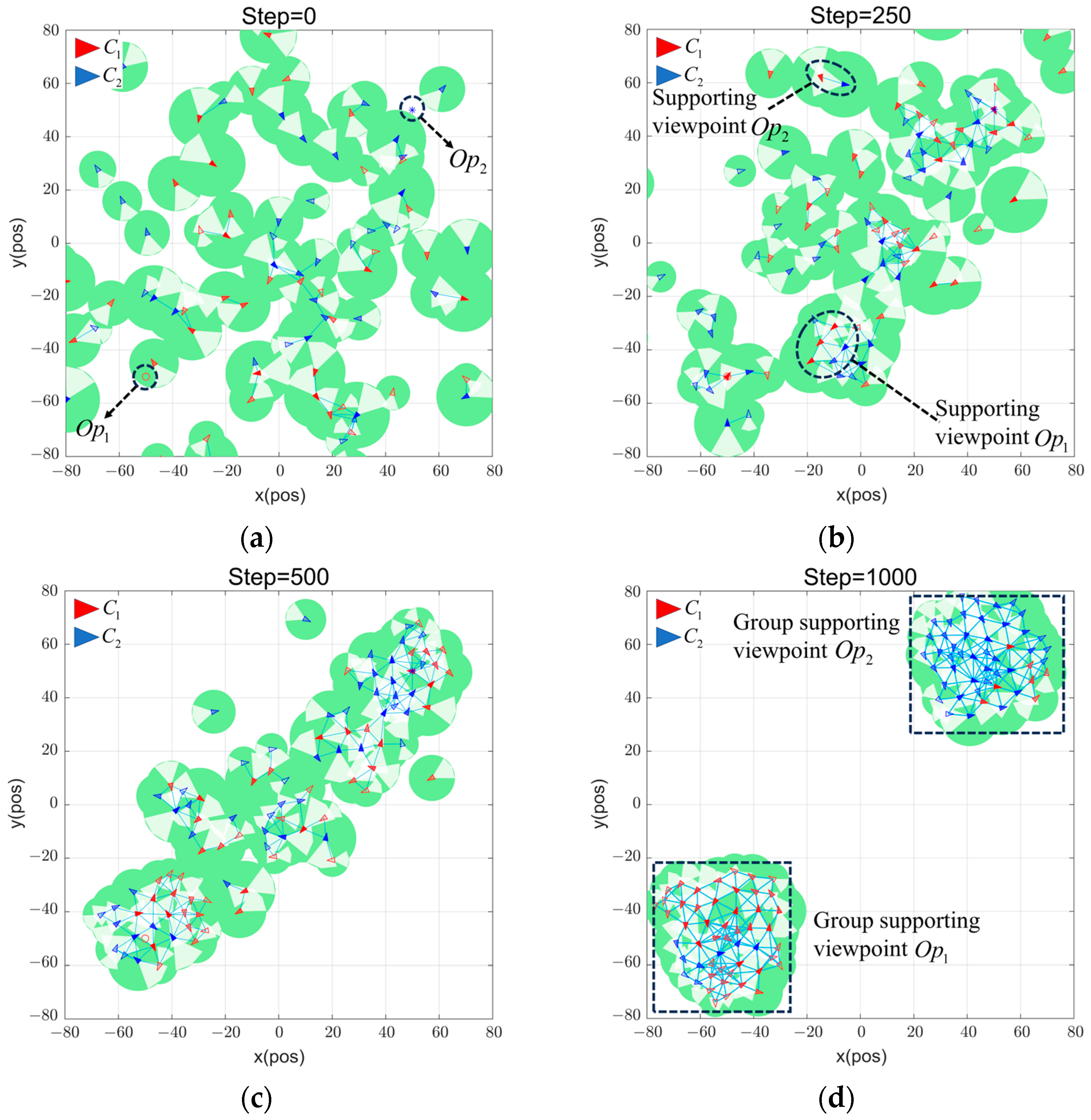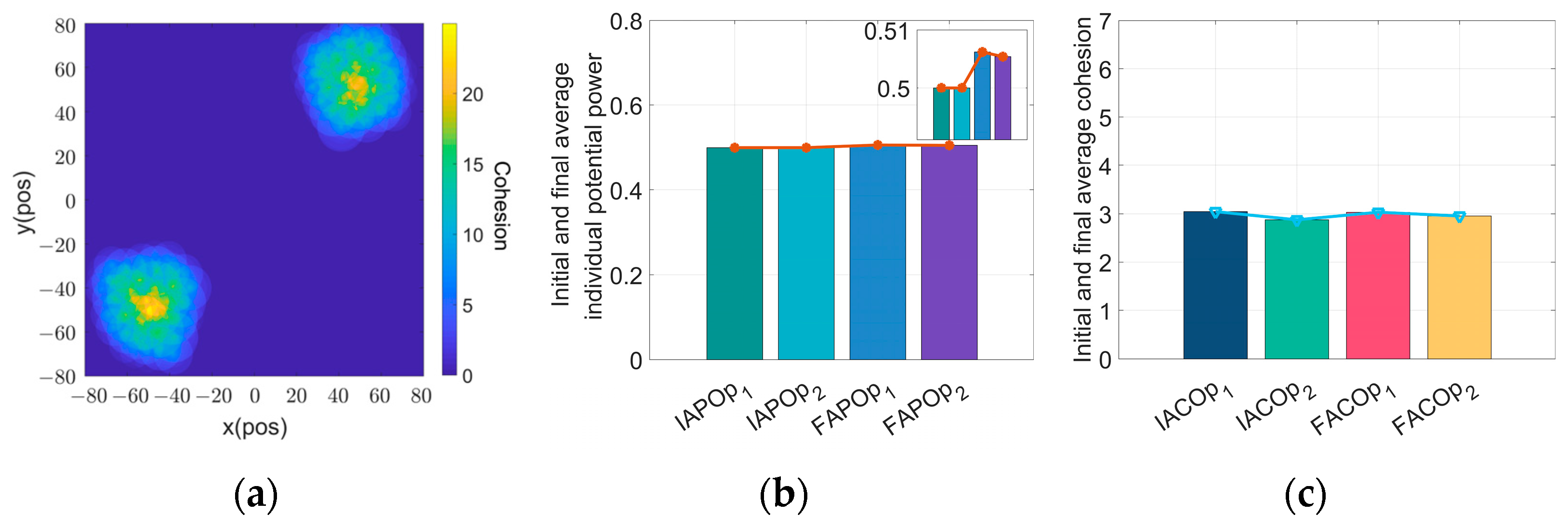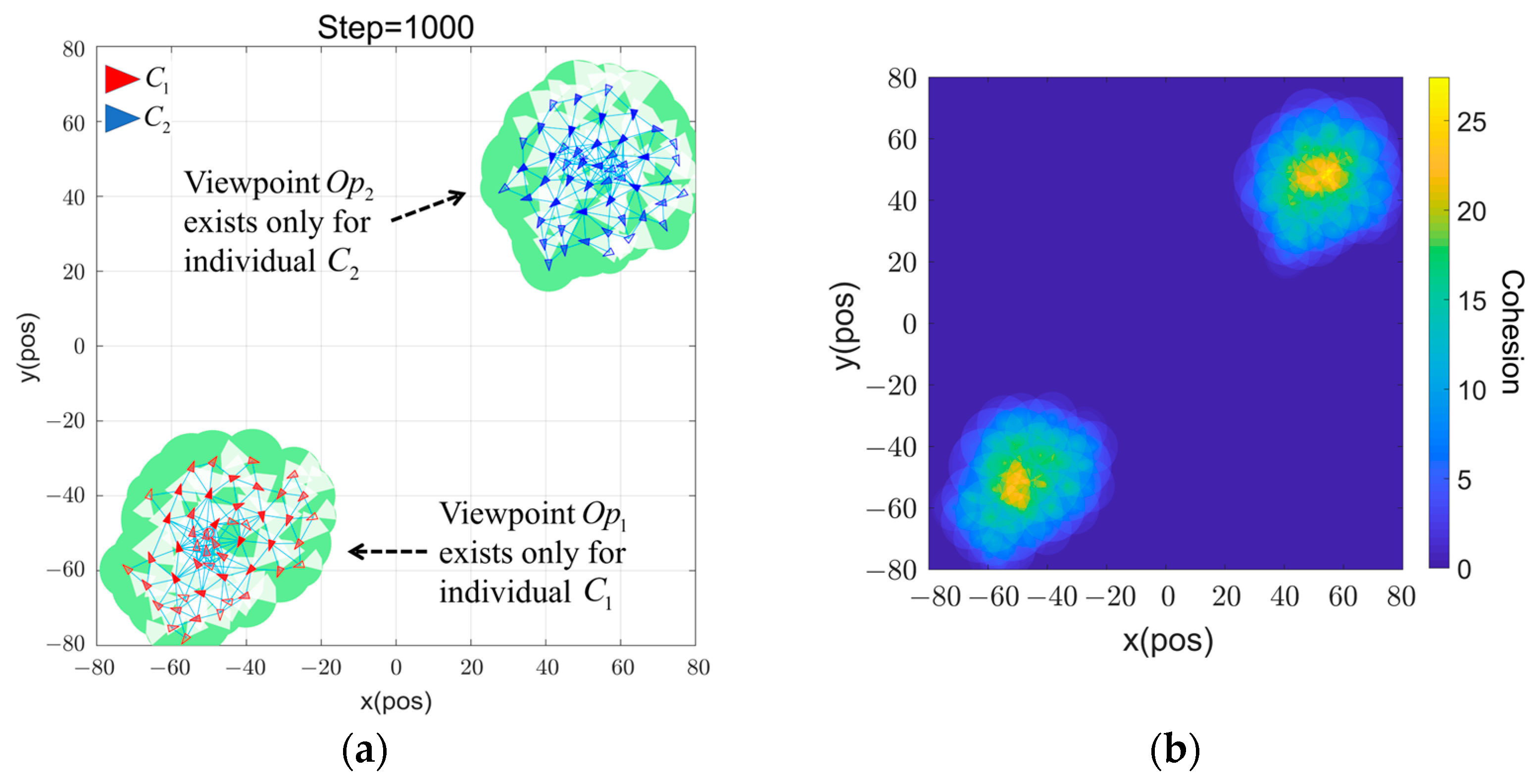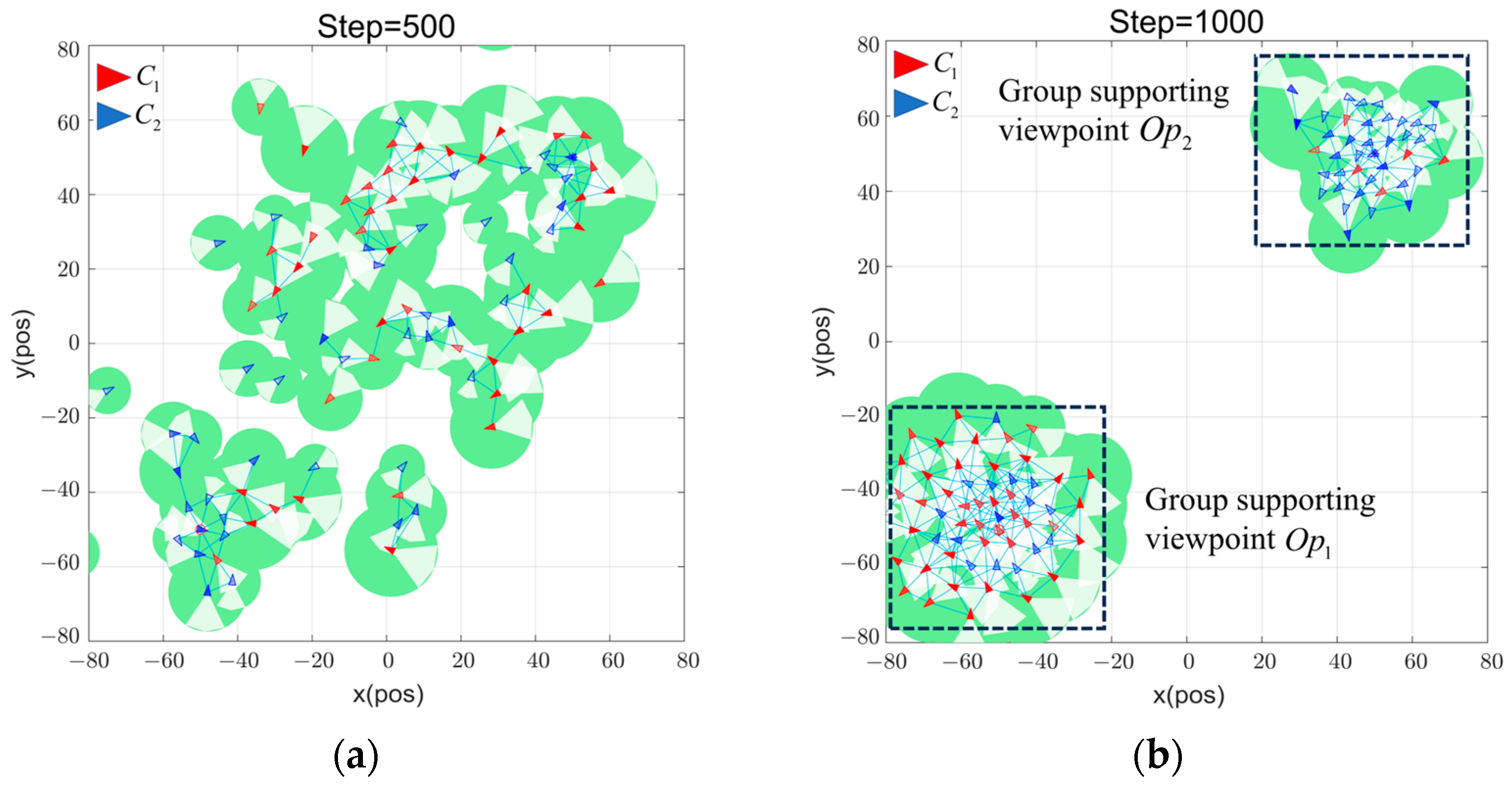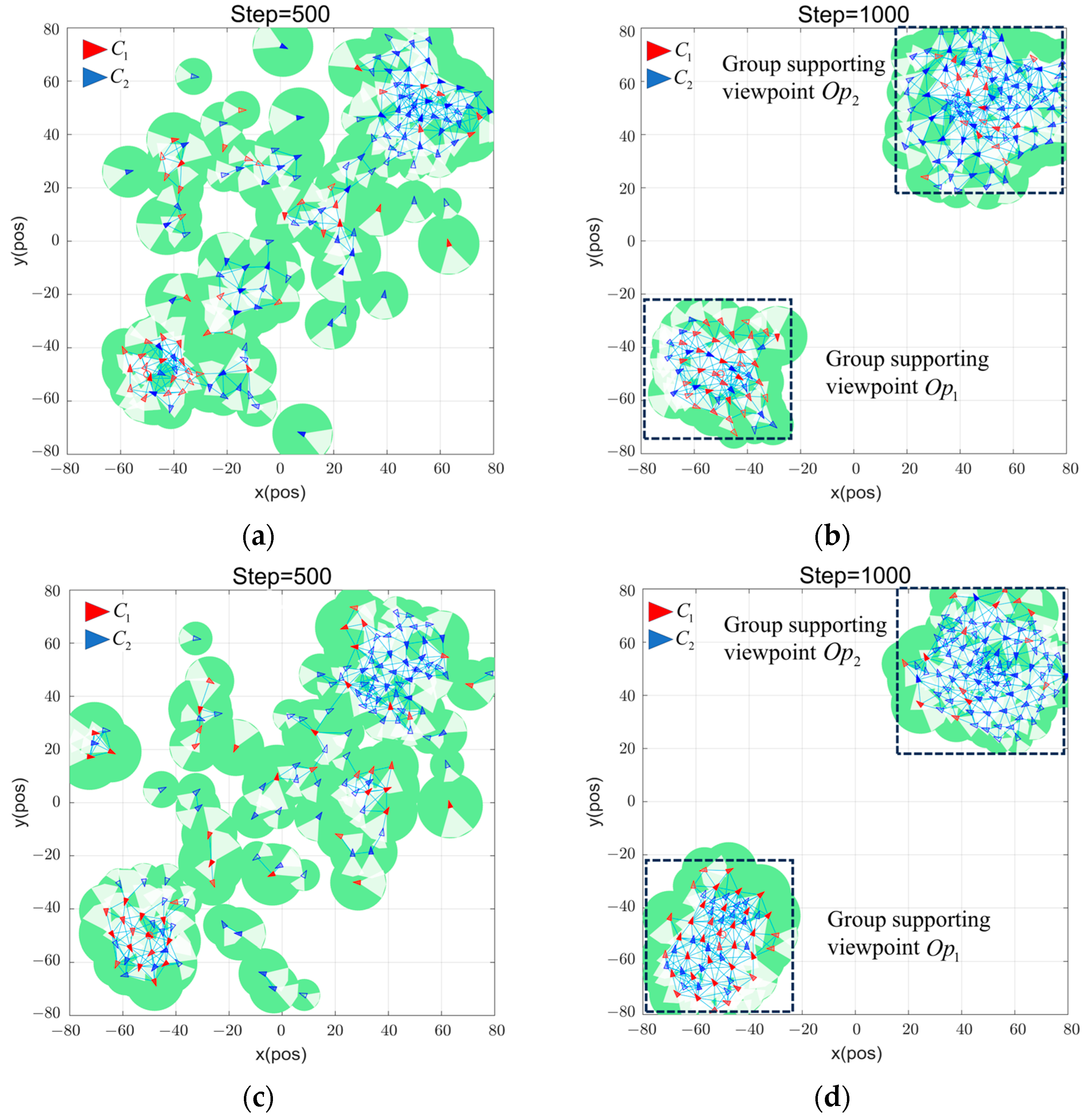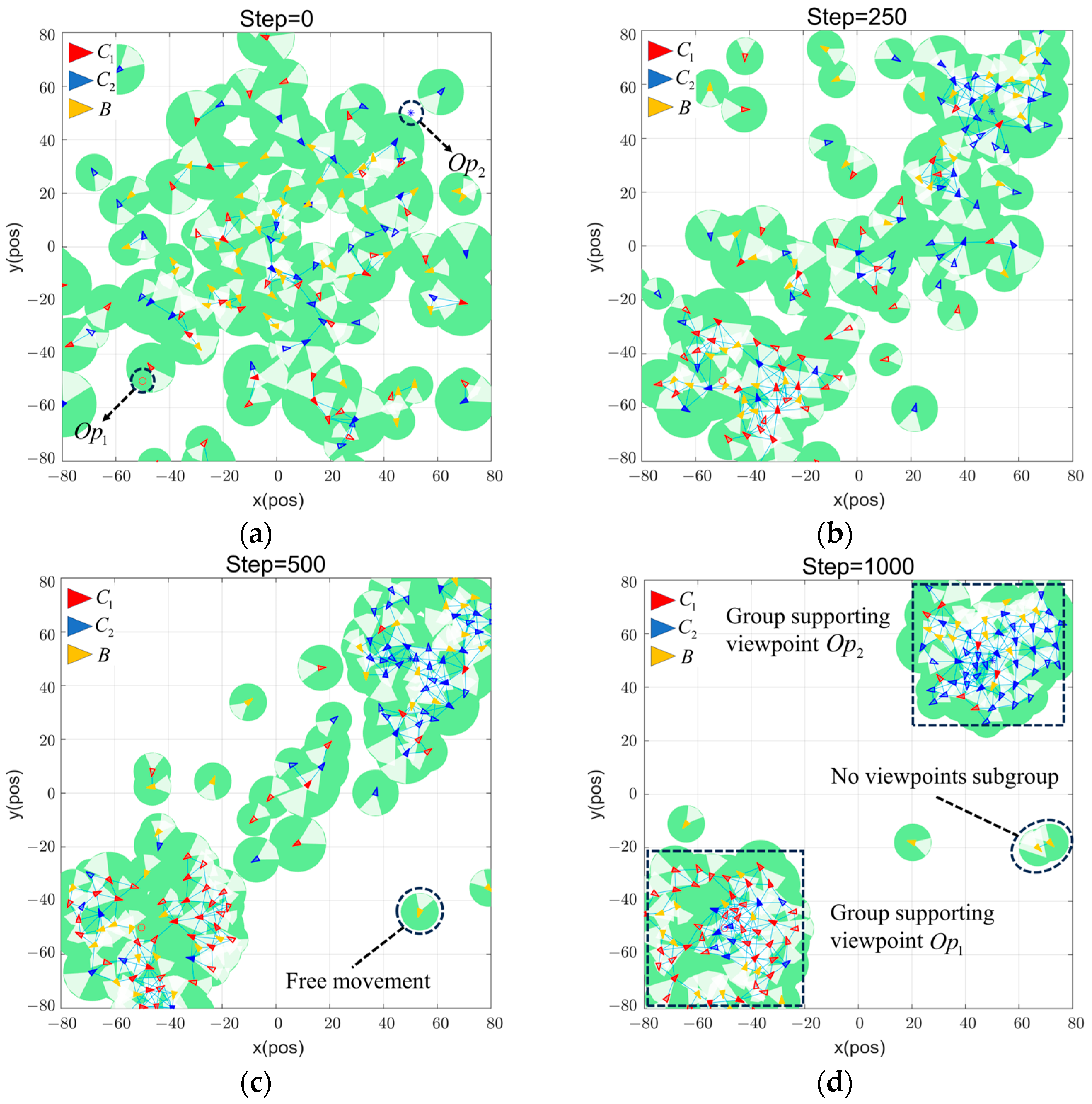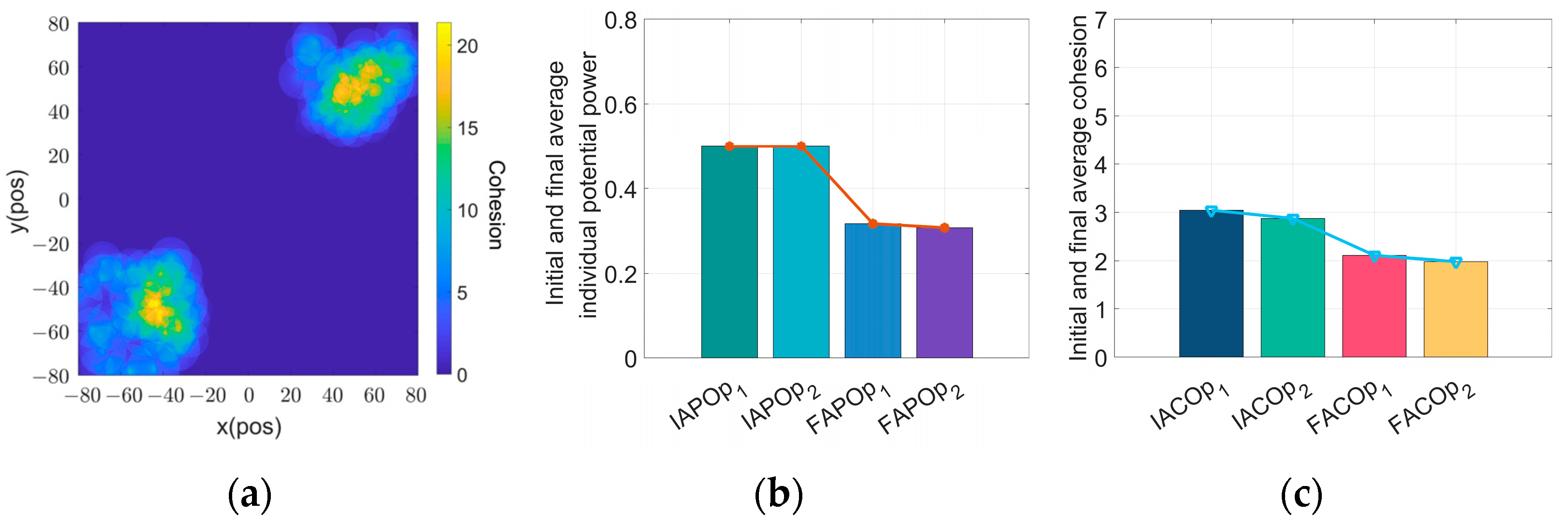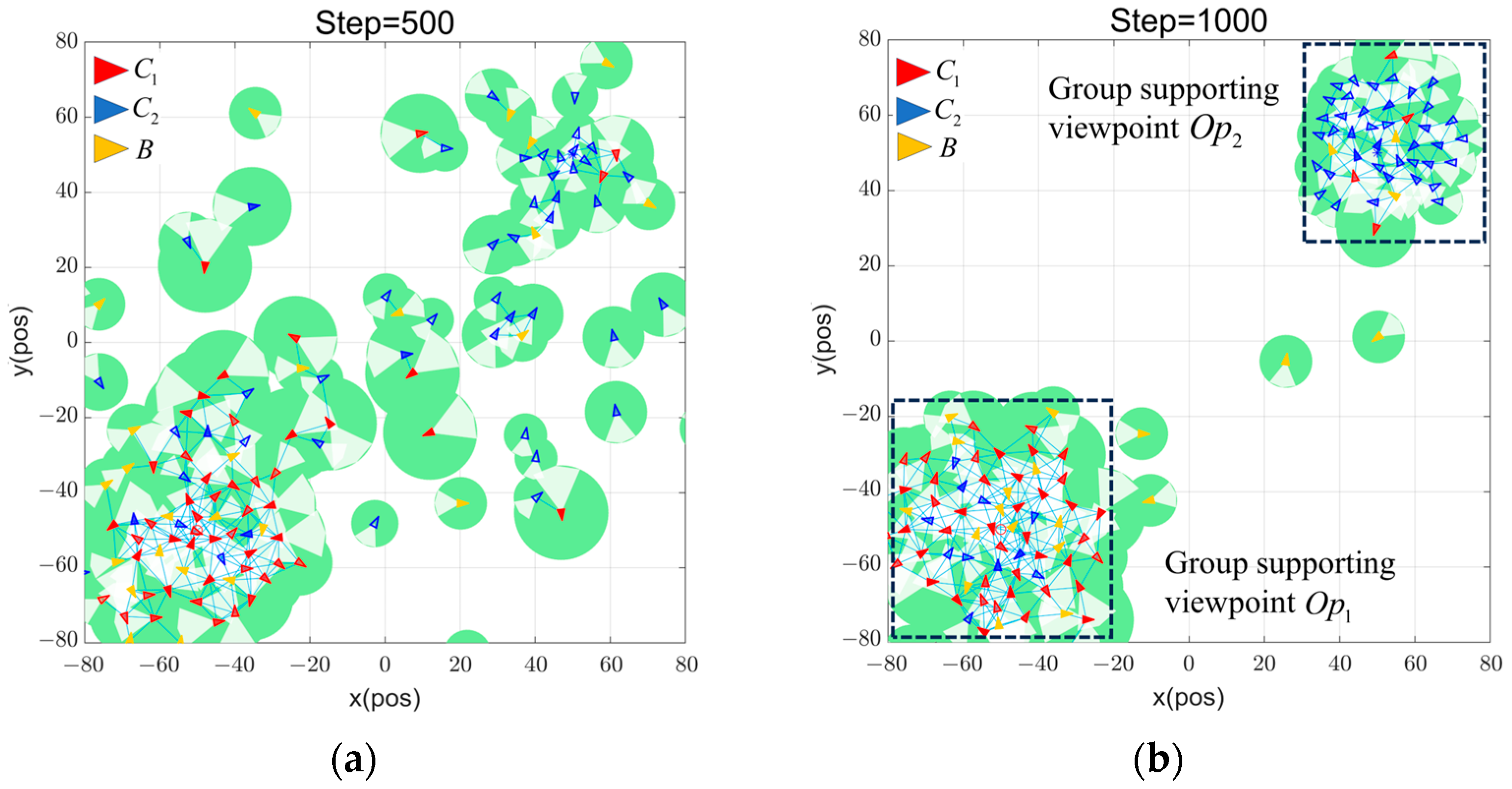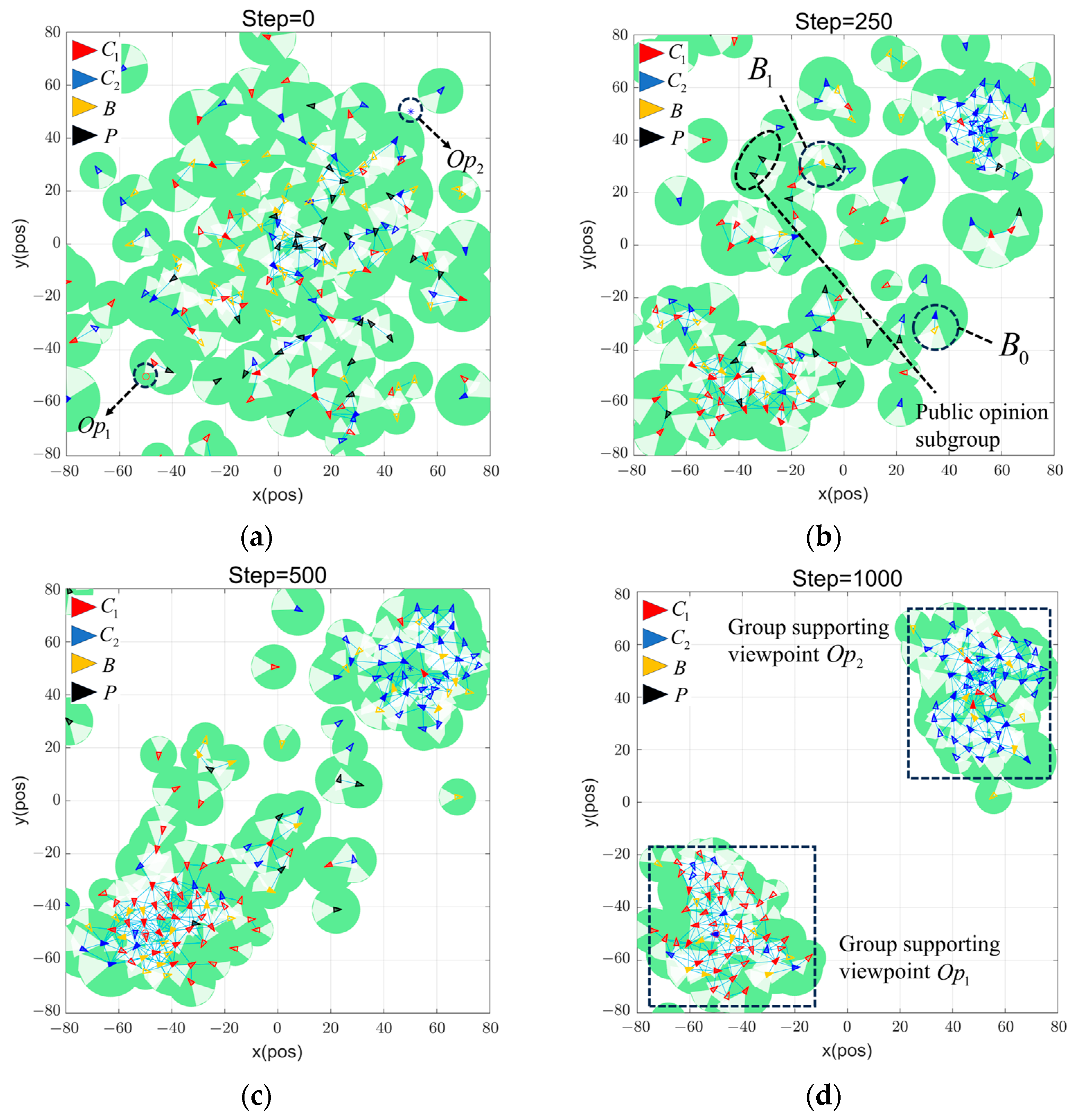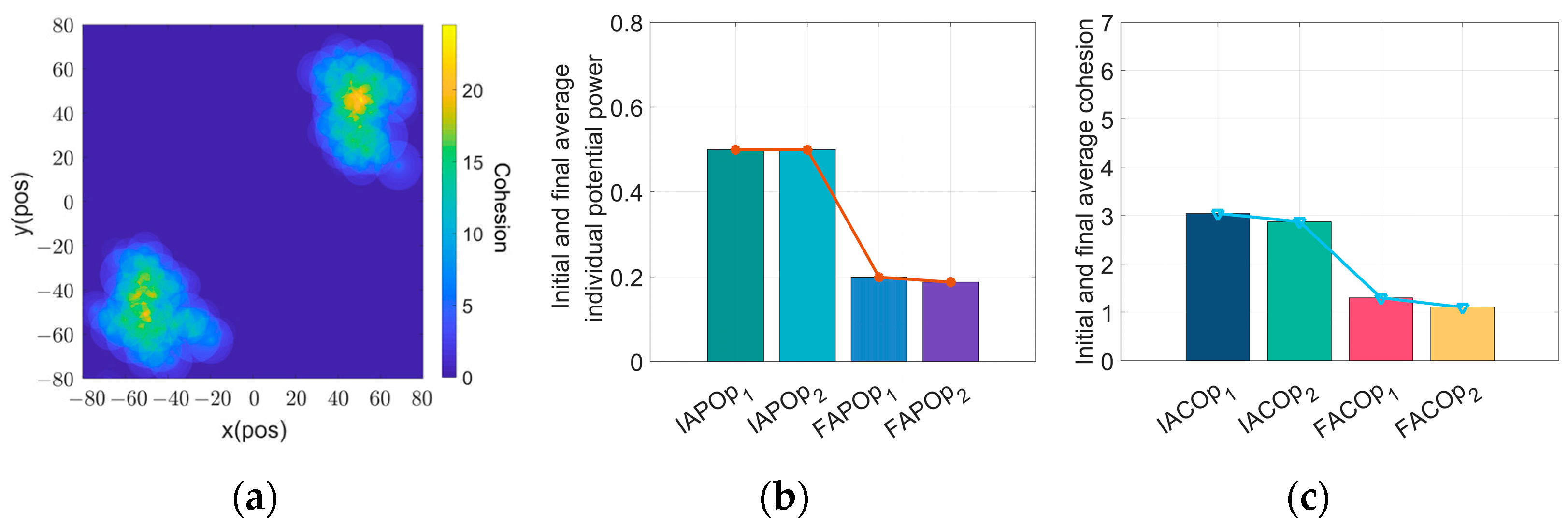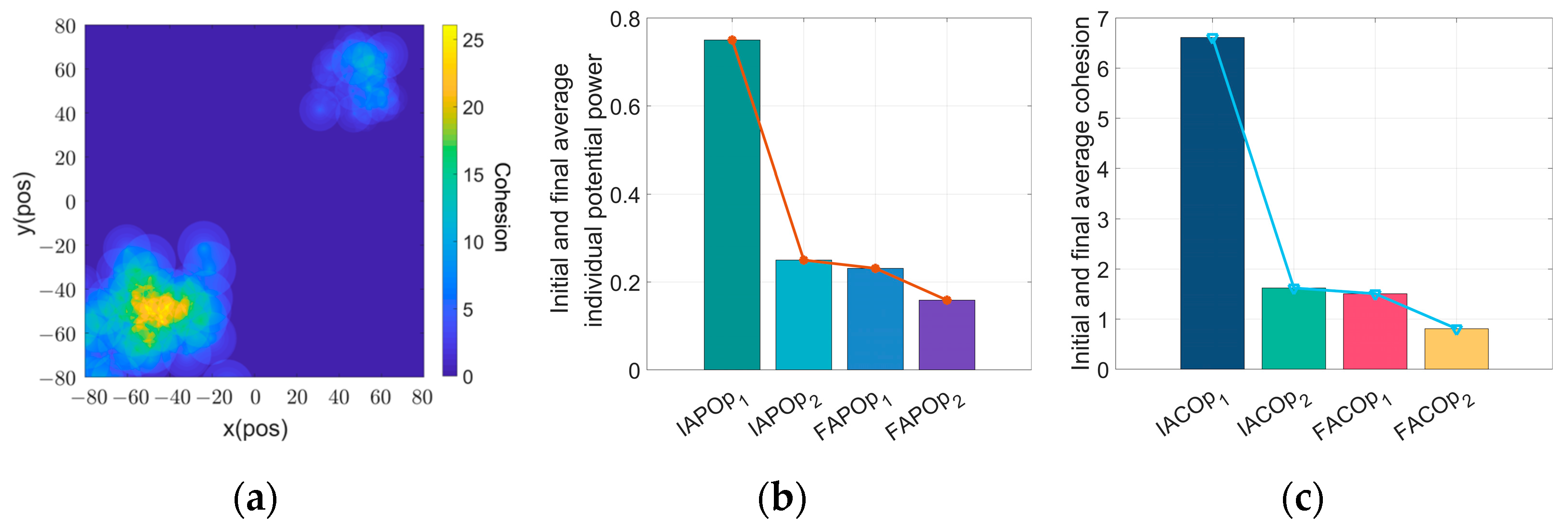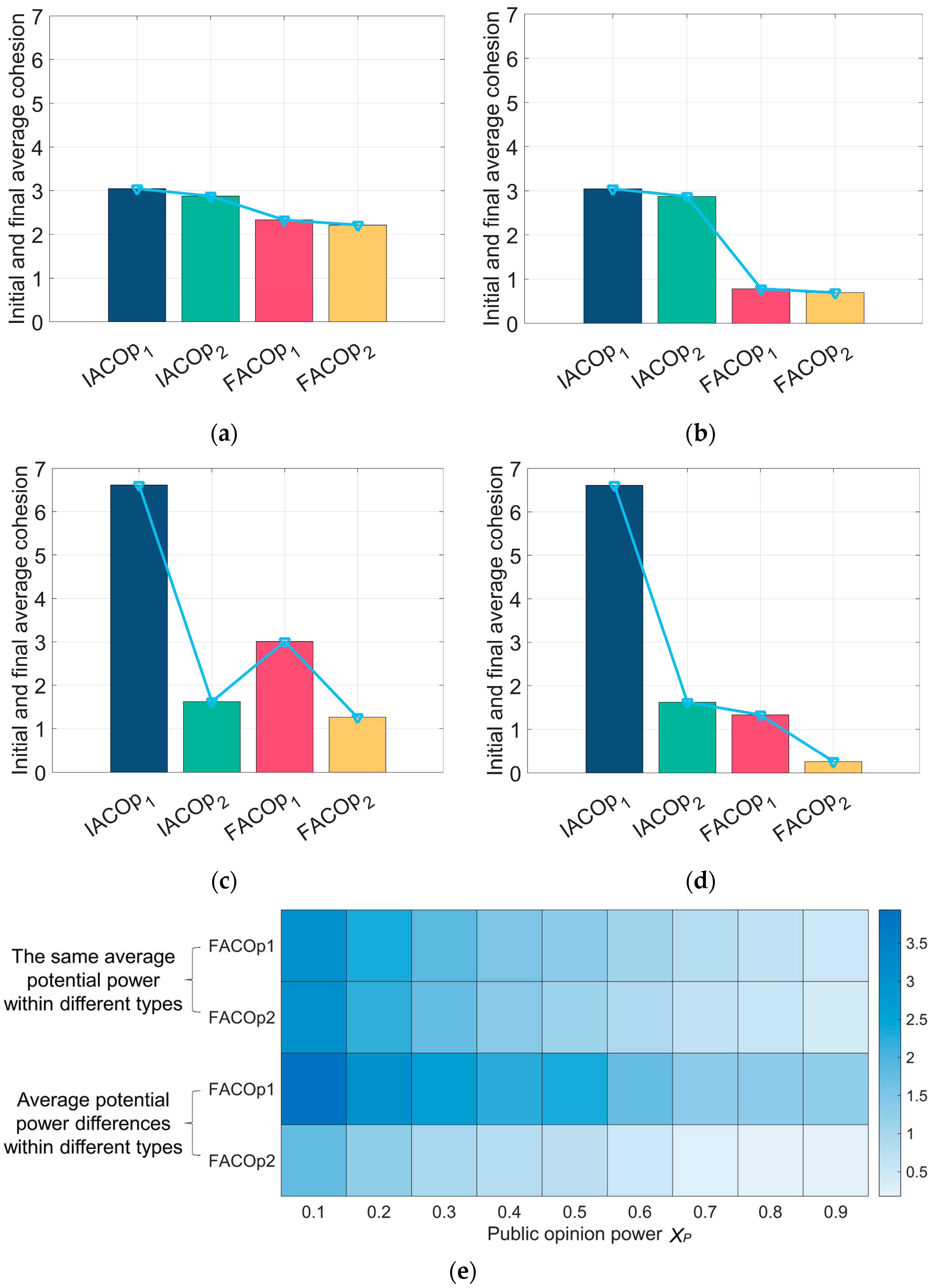1. Introduction
Groups are fundamental units within the social environment, offering numerous advantages over individuals working alone for accomplishing tasks [
1,
2]. The group effect is the collective behavioral phenomenon that emerges when individuals within a group are influenced and changed in terms of their behavior, attitudes, opinions, and perspectives. Group effects involve the process by which individuals interact with each other to form collective behaviors, including primarily the consistency effect, the herd effect, and the cohesion effect. Whether it is swarming insects [
3] and schools of fish in biology [
4,
5], active substance groups in physics [
6], or swarm robots in engineering [
7], group effects and collective behaviors are the outcomes of coordination among individuals [
8].
In group systems, individual characteristics play a critical role in shaping overall group dynamics [
9]. Understanding these characteristics and their impact on group dynamics and group effects is key to understanding the ecology of these systems [
10] and designing control rules in complex systems [
11]. Individual characteristics encompass a broad range of factors, including, but not limited to, physical characteristics (e.g., speed, direction, mass), cognitive characteristics (e.g., knowledge, potential powers), physiological characteristics (e.g., hunger, health status), and psychological characteristics (e.g., attitudes). The interaction of these characteristics influences individual behavior and directly impacts various group behaviors and effects. For example, in the butterfly effect phenomenon [
12], a single individual’s behavioral perturbation can propagate through an interconnected network, potentially leading to a collective effect. Recent studies on animal groups have shown that when the velocity or acceleration of individuals undergoes specific changes, the group enters various critical behavioral states [
13,
14,
15,
16]. External perturbations (e.g., the presence of a predator or the discovery of a critical resource) can induce sudden changes in the velocity of individual characteristics, prompting the entire group to adopt survival strategies such as resistance, aggression, or avoidance [
13,
15,
16]. Furthermore, the information and judgment abilities of individuals can lead to resource preferences and competition among individuals, resulting in variations in group consistency and disorder [
17]. However, such information can also regulate group adaptation and maintain group order [
18,
19]. For instance, individuals in a colony exhibiting more pronounced hunger characteristics may display more aggressive food-searching behaviors, which can improve the overall foraging efficiency of the group [
19].
Within groups, networks represent complex individual interactions among individuals [
20,
21,
22,
23]. Individuals with the characteristic of having varying interests exhibit cooperative and non-cooperative behavior within social groups, and their opinions fluctuate between cooperative and non-cooperative. Concurrently, the dissemination of opinions across the network ultimately influences the behavior of neighboring individuals and impacts both group cohesion and network density [
21]. In multi-domain groups (i.e., groups with distinct network layers), even if individuals within each domain exhibit non-cooperative or resentful tendencies, the presence of cooperative individuals across domains can foster consistency and enhance cohesion throughout the entire group [
22]. When an individual with an asymmetric potential power (which may arise from group structure, personal information, or interaction rules [
24]) is present, they may assume a leadership role, significantly influencing the group’s trajectory and behavior [
25]. Similarly, analyzing the characteristics of the individuals capable of altering group states, such as cohesion, polarization, or vortex formations, allows for precise adjustments of individual behaviors to achieve controllable transitions between different group states and effects [
26]. This paper focuses on the potential power inherent in individual characteristics, which influences individual behavior and roles within the group, thereby affecting group collective behavior and the cohesion effect.
Individual differences are prevalent across various group types, including animal and social groups. Examining this differentiation is essential for group cooperation and development. A growing body of research has emphasized the role of individual character differences, as they directly lead to varying group effects [
16,
17,
21,
27,
28,
29,
30,
31]. For example, the Axelrod model [
30] illustrates how local interactions lead to the emergence of cultural domains. In this model, an individual’s cultural characteristics are represented as a finite vector of pluralistic opinion states. After interacting with their neighbors, individuals copy some of their neighbors’ cultural traits, with the rate of change being proportional to the degree of similarity between the two individuals. Consequently, individuals tend to associate with others who share similar traits, leading to homogeneity. Building on this, Reia [
31] improved the model by introducing the concept of comfort level, which reflects an individual’s tendency to remain in a neighborhood based on the similarity of its neighboring individuals’ cultural characteristics. These models explain the varying group effects arising from individual characteristic differences through simple interaction rules.
Interestingly, most studies on group effects have focused on individual viewpoint shifts and decision making [
32,
33]. The dynamics of viewpoints is a critical area in group dynamics and group effects. In particular, external factors (e.g., public opinion dynamics, etc.) impact group effects and may lead to changes in the entire group’s behavior [
32,
33,
34,
35]. This paper explores how potential power differences in individual characteristics drive shifts in individual viewpoints and their subsequent impact on group cohesion. Here, we are mainly concerned with the group cohesion effect, which arises from the degree of firmness and identification with supported viewpoints following individual interactions. Group cohesion is crucial for maintaining and developing the group and directly influences the achievement of group goals [
36,
37,
38].
This paper builds on previous group dynamics models [
30,
31,
39,
40,
41,
42,
43] and presents an enhanced mathematical model to describe individual behavior in groups. In the model, we consider two types of individuals who support each of the two viewpoints. From the perspective of symmetry-breaking, we examine how differences in the potential power stemming from individual characteristics affect viewpoint shifts, decision making, and group cohesion for each viewpoint. An individual’s potential power is reflected in the firmness of their viewpoints and their perceptual range. Furthermore, we introduce an external perturbation variable to the model, representing individuals with no viewpoints and those with public opinion viewpoints. The main contribution of this paper lies in the mathematical model, designed to reflect the interaction of viewpoints and behavioral decisions among individuals, and the resulting different group behaviors and effects.
2. Preliminaries
2.1. Complex Network
Complex interactions among individuals in groups resemble a complex relationship network (as shown in
Figure 1a), where edges represent connections between individuals. These connections are often bidirectional, facilitating the exchange of information, exploration, suggestions, and more [
44]. Thus, complex networks are an indispensable theoretical and methodological tool for analyzing and understanding the complex structures and relationships within groups [
45]. Complex networks are composed of multiple undirected graphs (as shown in
Figure 1b), with “nodes” representing individuals and “edges” representing the links between them. The mathematical definition of the complex relational network is as follows:
Definition 1. For an undirected graph, G(t) = (V, E(t), A(t)), containing m individuals, where V = {1, 2, …, m} represents the set of individuals, and E(t) denotes the set of edges between individuals, that is, the set of interactions among individuals. represents the adjacency matrix, and if there is a link between individuals, then aij(t) = 1; otherwise, aij(t) = 0. The Laplacian matrix L = (lij(t)) is defined as L(t) = D(t) − A(t), where D(t) = diag(di) is the degree matrix, and di is the degree of node i. lij (t) = −aij(t), .
2.2. Individual Modeling
In groups, each individual needs to have a perceptual range in order to be able to interact with others around them. However, for most individuals in groups, there are limitations to the range of communication for each individual, and they are not always in contact with others. Consequently, each individual’s self-perception range is limited. Additionally, to avoid collisions in physical space during interactions, individuals need to maintain a safe distance from each other. Considering the possible actual field of view of an individual, we introduced this concept into the individual model. In summary, the individual model is illustrated in
Figure 1c. The arrow indicates the direction of the individual movement.
In
Figure 1c,
ds represents the safe distance required to avoid crowding and collisions.
r represents the perception range of an individual. The perceptual range,
r, is finite and always greater than
ds. In this model, the ratio of
r to
ds is fixed at 1.4 [
46].
θ represents the blind field of view range of an individual.
2.3. Inter-Individual Interaction
When individuals need to communicate and interact with each other, they need to approach each other to establish contact within their perceptual range, while simultaneously maintaining a safe distance to avoid collisions. Interestingly, the attraction and repulsion potentials in the potential function of molecular dynamics can accurately represent these processes. When two individuals are within the perceptual range, the attraction potential allows them to attract and move closer to each other. When the distance is smaller than is safe, the repulsion potential causes them to repel each other. In many studies on group dynamics, adopting the potential function to depict inter-individual interactions is both representative and effective [
46,
47,
48,
49,
50]. Therefore, in combination with the individual model presented in this paper, the potential function needs to satisfy the following conditions:
When the distance between individuals is less than the safe distance, ds, the potential function exhibits a repulsive potential to avoid collisions, even within an individual’s blind field of view θ.
When the distance between individuals is greater than the safe distance, ds, but smaller than the perception range, r, and within the individual’s field of view (2π − θ), the potential function exhibits an attractive potential to draw the two individuals closer to facilitate interaction and information exchange. If individuals are within the blind field of view range, θ, they do not attract each other.
When the distance between individuals exceeds their respective perceptual ranges, r, they are likewise independent of each other and do not influence each other.
Based on the above description, the potential function constructed in this paper is shown in Equation (1). The image of the potential function is presented in
Figure 2. Here, we set
ds = 5 and
r = 7, where
oij denotes the distance between individual
i and individual
j.
w denotes the potential function’s well depth. The schematic diagram of inter-individual interaction is shown in
Figure 3.
In
Figure 3,
fa is the attractive force, and
fr is the repulsive force.
dir denotes the current moving direction of individual
i.
β denotes the angle between the other individual
j and the current moving direction of individual
i. The specific expression of
β is as follows:
where ‖ ‖ denotes the Euclidean paradigm. When
β <
θ/2, it indicates that individual
j is within the blind field of view of individual
i, meaning they do not approach each other for interaction. Conversely, when
β ≥
θ/2, individual
j is within the field of view of individual
i and can interact and exchange information.
2.4. γ-Lattices and Quasi-γ-Lattices
One of our objectives is to design group mathematical models that enable a set of dynamic individuals to maintain a specific distance within a network
G(
o).
G(
o) is denoted as a spatially induced graph determined by the individual’s position, o, i.e., an undirected graph. Without the loss of generality, we assume that all individuals in the network will maintain the same distance, which leads us to consider the following set of algebraic constraints on inter-individual interactions:
where
denotes the set of neighbors of individual
i. The position,
o, of an individual is a solution to the constraint set in Equation (3). Therefore, it is convenient to define these solutions as lattice-type objects.
Definition 2. γ-lattice: a γ-lattice is a configuration, o, that satisfies the set of constraints in Equation (3). We denote ds and α = r/ds as the scales and ratios of the γ-lattice.
It is important to note that the
γ-lattice-induced undirected network,
G(
o), does not necessarily need to be connected. Common examples of two-dimensional
γ-lattices (where the interaction range
r =
αds, so
α = 1 +
ϑ and
ϑ > 0) include the square lattice, the hexagonal lattice, the set of vertices of the orthogonal polygon, and the Platonic cubic. An example of
γ-lattices is illustrated in
Figure 4.
Additionally, we consider slightly deformed γ-lattices, which are defined as shown below:
Definition 3. Quasi-γ-lattice: a quasi-γ-lattice is a configuration, o, that satisfies the following set of inequality constraints.
where
is the edge length uncertainty,
ds is the scale, and
α =
r/
ds is the ratio of the quasi-
γ-lattice.
E(
o) is the set of undirected graph edges of graph
G(
o).
To measure the degree of difference between the configurations
o and
γ-lattices, we use the following deviation energies [
42].
is the pair potential function (other scalar potentials can also be used). The deviation energy can be viewed as a non-smooth function of the
m-particle system. However, the
γ-lattice represents the global minimum of the potential function and reaches 0. For a quasi-
γ-lattice,
o, with an uncertainty in the edge length of
τ, the deviation energy is shown below:
This implies that the quasi-
γ-lattice is a low-energy conformation of
m nodes. The order of magnitude of the quasi-
γ-lattice deflection energy in
Figure 4b is
. Therefore,
α = 1.4 is justified. Next, we explain the reason for choosing
α = 1.4. For
γ-lattices, the induced undirected graph
G(
o) in
D dimensional space satisfies the following theorem.
Theorem 1 [
42]
. Let o be a γ-lattice with m different positional nodes of scale ds > 1 and a ratio of α > 1. Then- (1)
The graph G(o), induced by o, is a planar graph with D = 2, 3 dimensions.
- (2)
The graph G(o) has, at most, 3m-6 connected edges in D = 2 dimensions.
- (3)
The graph G(o), induced by a γ-lattice with the number of nodes m > D + 1 in D of dimensions 1, 2, and 3, will not constitute a complete graph.
According to part (3) of Theorem 1, the γ-lattice has the following characterization: If there is a moderate or large number of nodes in the lattice (m ≥ 4 nodes for D = 2), this leads to the fact that its spatially induced graphs G(o) are never complete graphs. This feature prevents us from using all-to-all networks to construct groups after the formation of individual interactions. Also, according to part (2) of Theorem 1, the total number of connected edges of the γ-lattice in D = 2 dimensions is linearly related to m.
Meanwhile, Theorem 1 also restricts the maximum ratio of the planarity of the graph induced by the
γ-lattice to the perception range,
r, and the safe distance,
ds. For example, a cubic lattice,
o, in dimension
D is an effective
γ-lattice with a ratio of
α = 1 +
ϑ if
. Otherwise, the two nodes on either side of the hypercube’s diagonal will be neighbors, which will make
o become an ineffective
γ-lattice. Therefore, each node is unable to maintain an equal distance between itself and all its neighbors (i.e., safety distance constraints). We show this result in the form of the
D = 2 dimensions in
Figure 5.
In summary, without the loss of generality, in order to allow individuals to interact fully in space and to satisfy the above conditions ( in Equation (7), 1 + ϑ < ), we set the ratio of the perception range, r, to the safe distance, ds, to be 1.4.
2.5. Individual Potential Power Differences
The potential power of an individual refers to the influence and capacity that the person can exert, stemming from factors such as skills, knowledge, and experience. Within a group, differences in individuals’ potential power can lead to differences in knowledge and spheres of influence, which in turn shape their roles and abilities. Individuals with extensive knowledge and a broad sphere of influence often act as leaders, guiding others in decision-making processes. In the context of this paper, potential power differences are reflected in the degree of firmness of individuals’ viewpoints and their perceptual range. Those with a higher potential power generally have deeper insights and a more comprehensive understanding of their perspectives, demonstrating greater firmness to their viewpoint. Conversely, individuals with a low potential power have less knowledge and exhibit weaker firmness with their viewpoint. These differences in potential power contribute to variations in individual behavior, thereby shaping group dynamics. When individuals with different potential powers interact, they communicate about their viewpoints and knowledge reserves. Those with higher potential power tend to persuade individuals with lower potential power, leading them to align with and “follow” the more powerful individual in decision making. In other words, differences in individuals’ potential power correspond to differences in leadership ability.
We represent this state of “following” as an attractive force between individuals. Specifically, the more powerful individual attracts the less powerful individual to make their decision. In the mathematical model, the well depth in the potential function represents the magnitude of potential power. In [
49], it was demonstrated that the well depth is positively correlated with the strength of attraction. Additionally, an individual’s leadership ability is determined by both their potential power and their perceptual range [
46]. The greater an individual’s potential power and perceptual range, the stronger their leadership. Therefore, considering a group containing
m individuals, we define the well depth parameter for each individual as
and
Xi ∈ [0, 1].
Xiw represents the potential power of individual
i. The larger the
Xi is, the higher the individual’s firmness in their viewpoint and potential power. The perceptual range and safe distance of individual
i are
ri =
ξ(
Xi +
k) and
dsi =
ri/
α, respectively, where
and
are positive numbers. Since the ratio of
ds to
r is fixed, the potential function’s well depth,
w, is fixed for each individual according to Equation (1), as shown in Remark 1.
Remark 1. The attraction potential used for interactions between individuals depends on the potential function’s well depth. For the potential function P(oij) (as in Equation (1)), the well depth is the vertical distance from the minimum point of the potential energy (global minimum) to the steady state point (limit) of the potential energy within the range of individual interactions [49], denoted aswhere k2 is a constant. Thus, the value of the well depth corresponding to each individual is fixed when the perception range, r, is proportional to the safe distance, ds. 3. Mathematical Models Describing Individual Behavior
In this section, we present a detailed mathematical model and corresponding formulas describing individual motions. In our model, all the individuals in the group are classified into two types, each supporting one of two viewpoints, denoted as Op1 and Op2. The individuals supporting Op1 are labeled as type C1 individuals, and the individuals supporting Op2 are labeled as type C2 individuals. Within each type, there are potential power differences, as well as differences in the potential power between the individuals of different types. The two types of individuals’ initial positions are randomly distributed within a finite space and obey a Gaussian distribution. The interactions between individuals influence their final decisions. Through the interaction results, we can observe the impact of the potential power differences on the structure and cohesion effect of each viewpoint group. It is important to note that viewpoints Op1 and Op2 are not antagonistic or mutually exclusive; instead, they represent different approaches to solving the same problem.
In terms of external perturbations, we introduce two additional types of individuals: individuals with no viewpoints (type
B individuals) and individuals with public opinion viewpoints (type
P individuals). Individuals with no viewpoints lack specific viewpoints and, thus, have no potential power in the model, yet they retain the perceptual range to interact with other individuals. Individuals with public opinion viewpoints possess public opinion power, which can influence the potential power of other individuals, thereby affecting their decision-making processes. Consequently, both types of external perturbations affect type
C1 and
C2 individuals, leading to varied behaviors and ultimately affecting the group cohesion effect with each viewpoint. The analysis schematic of this study is depicted in
Figure 6. The detailed interaction rules and mathematical models describing the interactions between these different types of individuals are presented in the following sections.
3.1. Only Two Types of Individuals—C1, C2
When there are only two types of individuals and no external perturbations, the total number of individuals,
m, is the sum of type
C1 and
C2 individuals (i.e.,
m = C1 +
C2). Both individuals of the same type and different types can interact with each other. The interaction diagram and the interaction rules between individuals are illustrated in
Figure 7 and defined as follows:
Interaction rules of type C1 and C2 individuals:
When two individuals,
i and
j, in the same type interact (
or
), the individual with the lower potential power will always obey and “follow” the individual with the higher potential power, thereby supporting the same viewpoint (
Figure 7b,c)
When two individuals,
i and
j, belong to different types, if the potential power of individual
i (of type
C1, initially supporting
Op1) is stronger than that of individual
j (of type
C2, supporting
Op2), then after the information exchange and communication during the interaction, individual
j will “follow” individual
i and ultimately support
Op1 (
Figure 7d). In this process, if a higher potential power individual,
k, who supports
Op2, interacts with
i and
j (i.e.,
), then individuals
i and
j will also “follow” that higher potential power individual,
k, and this will ultimately lead to individuals
i,
j, and
k supporting
Op2 (
Figure 7e).
According to the above rules, we build upon the Olfati model [
42,
51,
52,
53] and integrate it with the individual model described in
Section 2 to establish this paper’s mathematical framework. This framework [
30,
31,
41,
46,
51,
52] encompasses diverse forms of interactions, including, but not limited to, aligned movement, collision avoidance between individuals, and guidance mechanisms for individuals to navigate toward the corresponding viewpoint. To describe the motion of each individual in two-dimensional space, we employ a second-order continuous motion equation, as described by the following formula:
where
represents the position of individual
i and
represents the velocity of individual
i.
represents the control input for the movement of individual
i, which is expressed as follows:
is the interaction term used to represent the interaction process between individuals. For the case of only two types of individuals (type
C1 and
C2 individuals), the specific expression is
They can only attract each other for interaction within the individual’s field of view.
denotes the set of other individuals within the perceptual range of individual
i at time
t. Since
,
can represent the potential power of individual
j within the perceptual range of individual
i.
and
denote the attraction and repulsion potentials in Equation (1), respectively.
is the connection vector between individual
i and individual
j,
.
is the speed-matching term between individuals. When individuals interact with each other, individuals with a lower potential power will “follow” individuals with a higher potential power and support the final viewpoint. In order to sustain this “following” state and connection, it is necessary to ensure that individuals keep a fixed safe distance from one another, which requires matching speeds. Specifically, the speed of the individual with lower potential power will actively adjust to match the speed of the individual with higher potential power. The expression for
is shown below:
Similarly, speed matching is only possible within the individual’s field of view and is not possible within each other’s blind field of view. is the adjacency matrix between individuals i and j (as shown in Definition 1).
denotes the initial viewpoint support term for each individual. In this model, two viewpoints,
Op1 and
Op2, are introduced, and while type
C1 and
C2 individuals initially support these viewpoints, their initial viewpoint support terms are the same—only the types differ. In the mathematical model, we represent this support for the viewpoint as the individual’s position converges to the viewpoint position. Then, the initial viewpoint support term for each type of individual is shown in Equation (14).
where
and
are the positions in two dimensions of the
Op1 and
Op2, respectively.
3.2. Three Types of Individuals—C1, C2, and B
In this section, we introduce an external perturbation, i.e., the individuals with no viewpoints,
B. The total number of individuals becomes
m =
C1 +
C2 +
B. Since individuals with no viewpoints do not have any viewpoints, they are influenced only by type
C1 and
C2 individuals, and do not impact them in return. So, type
B individuals have no potential power, i.e., no attraction potential or well depth in the potential function. However, type
B individuals still retain their perceptual range and safe distance, allowing them to interact with others (being guided) while avoiding collisions. Therefore, the interaction diagram and the interaction rules for these three types of individuals are shown in
Figure 8 and are defined as follows:
Interaction rules of type C1, C2, and B individuals:
Type
C1 and type
C2 individuals interact with each other in the same manner as described in
Section 3.1 (
Figure 7).
When type
C1 individuals interact solely with type
B individuals, or type
C2 individuals interact solely with type
B individuals (
), type
B individuals will “follow” the type
C1 or
C2 individuals and eventually support the corresponding viewpoint (
Figure 8b,c).
When type
B individuals interact with both type
C1 and
C2 individuals (
), type
B individuals will “follow” the high potential power individual of the interacting type
C1 or
C2 individuals, supporting the corresponding viewpoint. Thus, individual
i ultimately leads to individuals
j and
k supporting
Op1 (
Figure 8d).
When type
B individuals interact with each other (
), they do not actively approach one another to exchange information (
Figure 8e).
According to the above rule, when there are three types of individuals, their interaction term
is shown below:
However, the speeds of individuals belonging to the same type
B can be matched, thus creating the “no viewpoints subgroups”. The speed match terms
are shown below:
Since type B individuals have no initial viewpoint, there is no individual initial viewpoint support term. Only type C1 and C2 individuals have viewpoint support terms. Therefore, in the case of three types of individuals, is the same as in Equation (14).
3.3. Four Types of Individuals—C1, C2, B, and P
In this section, we introduce another external perturbation: the individuals with public opinion viewpoints,
P. Thus, the total number of individuals becomes
m =
C1+
C2 +
B +
P. The individuals with public opinion viewpoints have their own potential power, i.e., the public opinion power, which is determined by the magnitude of their well depth parameter. It is crucial to note that type
P individuals can only influence the potential power of type
C1,
C2, and
B individuals but do not “follow” them to support their respective viewpoints. Furthermore, the perceptual range of type
P individuals increases with the degree of their public opinion power. The interaction diagram of these four types of individuals and the interaction rules are shown in
Figure 9 and are defined as follows:
Interaction rules of type C1, C2, B, and P individuals:
Type
C1 and type
C2 individuals interact with each other in the same manner as described in
Section 3.1 (
Figure 7).
Type
B individuals interact with type
C1 and
C2 individuals and with the same individuals with no viewpoints, type
B, in the same manner as described in
Section 3.2 (
Figure 8).
When type
P individuals interact with type
C1 and
C2 individuals, type
C1 and
C2 individuals compare their own potential power magnitude with type
P individuals. (1) If the potential power of type
C1 and
C2 individuals is less than that of type
P individuals (
), it indicates that public opinion has influenced them, weakening the firmness of their respective viewpoints, thereby reducing their potential power (
,
Figure 9b). (2) If the potential power of type
C1 and
C2 individuals is greater than that of type
P individuals (
), type
C1 and
C2 individuals will remain unaffected by public opinion (
Figure 9c), i.e.,
where
. If
, then
.
When type
P individuals interact with type
B individuals, the lack of viewpoints in type
B individuals results in them acquiring a degree of stubbornness (potential power) from type
P individuals, making them less susceptible to influence by type
C1 and
C2 individuals. We label the type
B individuals who are not influenced by the type
P individuals as
B0 and those who are influenced by the type
P individuals and possess a degree of stubbornness as
B1 (
Figure 9d). Then,
,
.
Type
B individuals with this acquired stubbornness exhibit the following behaviors when interacting with type
C1 and
C2 individuals: (1) If the degree of stubbornness of type
B1 individuals exceeds the potential power of type
C1 and
C2 individuals, they remain uninfluenced and do not support any viewpoint (
Figure 9e). (2) If the degree of stubbornness of type
B1 individuals is less than the potential power of type
C1 and
C2 individuals, they are guided by these individuals and “follow” them in supporting the corresponding viewpoints (
Figure 9f). Of course, the final support still depends on the potential power of the interacting type
C1 and
C2 individuals.
According to the above rule, when there are four types of individuals, their interaction terms
are shown as follows:
Similarly, speeds can be matched between the individuals of the same type,
P, thus creating “public opinion subgroups”. The speed match terms
are shown below:
Since type P individuals only influence the potential power of type C1, C2, and B individuals and do not follow them in supporting the corresponding viewpoints, there is no individual initial viewpoint support term. In the case of four types of individuals, is the same as in Equation (14).
3.4. Group Cohesion Effect
The group cohesion effect refers to the strength of individuals’ connections within a group, which is driven by their identification with a particular viewpoint. In the context of this paper, the group cohesion effect is conceptualized as group cohesion in support of a viewpoint (
Op1 or
Op2), which manifests as the intensity of the connections between individuals. This intensity is evidenced by the attraction between individuals. Consequently, the formula for calculating the average group cohesion
that supports each viewpoint after individual interactions is provided in Equation (27). The average individual potential power of all the individuals that support each viewpoint is provided in Equation (28).
where
and
are denoted as the number of individuals who ultimately support
Op1 and
Op2, respectively. The average potential power of individuals describes their decision-making ability and viewpoint leadership ability.
5. Discussion
In this section, we better align the individual model with real-world scenarios and relate the analyzed results to practical applications, particularly in the context of social networks and organizational behavior.
5.1. Connection Between the Individual Modeling and the Real-World
In this paper, we define individuals with characteristics such as a perception range, safe distance, field of view, and potential power to facilitate scaling to real-world applications. In a practical context, such as individuals within a social network, their perception range can be regarded as the influence area in which an individual can both receive and exert information. Specifically, it is the range of social connections that an individual uses to reach and receive information from his friends, followers, and other group members in a social network. The safe distance can be understood as the psychological distance for individuals to avoid excessive proximity and maintain personal space in social interactions. In social networks, this psychological “comfort zone” (safe distance) manifests as an individual choosing to keep a certain distance when interacting with others to mitigate psychological pressure from overly close interactions. For example, individuals may avoid interacting with strangers or overly aggressive individuals to maintain their psychological boundaries. Additionally, maintaining a fixed ratio between the perception range and the safe distance suggests that as an individual’s perception range expands, their psychological safety distance similarly grows. This dynamic explains why, in certain social networks, relationships may tend to become more cautious or decentralized as the interaction frequency increases. For instance, when an individual has more social media friends, they may tend to share information more cautiously and maintain a certain “social distance” to avoid being influenced or psychologically pressured by too many individuals.
The field of view range represents the breadth of information an individual can receive, with some information being captured by the individual while others are ignored. The potential power signifies an individual’s capacity or influence. In a social network, an individual with a high potential power, such as a public figure or expert, tends to possess greater credibility and a higher level of influence.
The individual model is also applicable in various practical engineering applications. For example, in systems such as clustered robots, swarm UAVs, or intelligent transportation systems, the perception range of each robot or vehicle can be defined as the maximum distance at which it can detect other individuals or receive data from sensors (e.g., radar, laser radar, or cameras). Within this range, individuals can engage in coordinated movement, flight, or information sharing. The safety distance is intended to avoid collisions or affect the stability of the swarm during cluster control. For example, if the distance is too close, it may result in physical collisions or data interference, impairing the group’s overall performance. Maintaining a fixed ratio between the perception range and the safety distance implies that in certain applications, as the flight speed of an individual or swarm increases, the perception range may need to be extended, which in turn requires an increase in the safety distance to avoid collisions at higher speeds. The field of view represents the area covered by its sensors. At the same time, the potential power reflects the leadership and decision-making ability of the individual, i.e., by guiding other robots to perform a specific behavior, such as rounding up a target, tracking an object, or forming a formation.
5.2. Connection Between the Mathematical Model and Real-World Applications
In the model, we examined how the average potential power of two types of individuals affects group cohesion and individual decision making. We then extended this analysis by introducing individuals with no viewpoints and individuals with public opinion viewpoints. Next, we will draw connections to real-world applications. The specific analysis is as follows.
5.2.1. The Case of Two Types of Individuals
For the case of only two types of individuals (type C1 and C2 individuals), the model demonstrates that in social groups, when individuals supporting different viewpoints make decisions after interactive discussion and negotiation, the individuals with the higher potential power tend to have a stronger influence on group decision making. For example, in organizational teams or social networks, more authoritative or expert individuals (such as KOLs, i.e., Key Opinion Leaders) often guide the direction of discussions, leading to a greater consensus around their viewpoints.
In the context of elections, certain voter groups may exhibit strong, unwavering support (i.e., potential power) for a particular candidate, and their votes remain steadfast in the face of a campaign opponent. If these voter groups have a higher average potential power, their collective decisions can significantly impact the election’s outcome. For example, in a U.S. election, where voters in certain regions may have long supported a partisan candidate, these voter groups display high voter loyalty and may form a cohesive group that ultimately sways the election results in that region.
In marketing and consumer behavior, consumer decisions are not only influenced by product quality but also by emotional attachment and brand loyalty (i.e., potential power). Groups of consumers with strong brand loyalty wield a greater potential power, thus influencing the purchasing decisions of other consumers. A notable example is Apple’s loyal customer base, whose strong brand identification and unwavering support confer significant influence in the market. To enhance market competitiveness, a brand marketing team could strategically appeal to these loyal consumer groups to influence more potential consumers through social communication and word-of-mouth effects.
This analysis highlights the importance of rationally distributing individual potential power within a group, as it directly impacts the group’s cohesion and influences its future trajectory. These insights are particularly relevant for organizational behavior, where balancing power dynamics can impact team performance and decision outcomes.
5.2.2. The Case of Individuals with No Viewpoints Exists
With the introduction of a third type of individual (type B, representing those without viewpoints or new participants), the model reflects the dynamics in social networks when new individuals join an existing group. These “no-viewpoint” individuals significantly affect the overall group cohesion, often balancing the influence between groups with differing viewpoints. Furthermore, groups with a high potential power are more attractive to these new or undecided individuals than those with a weak potential power, increasing their size. This dynamic suggests that in real-world social networks, the size and cohesion of a group can be enhanced by increasing the potential power of individuals, thus attracting more members and stabilizing the group environment.
For example, in social networks, the individuals with no viewpoints may be those users who lack a clear stance on an issue, i.e., users who browse information but refrain from participating in discussions. Through their “neutral” or “ambiguous” stance, these individuals with no viewpoints can balance the group cohesion of different viewpoints in a certain way. For example, in a discussion on a social topic, a large number of individuals with no viewpoints may form a “bridge” between the two factions, avoiding the over-polarization of either side and pushing the discussion to maintain a certain balance.
In the context of election campaigns, individuals with no viewpoints can be analogized to voters who are undecided about voting or who do not have a clear preference for the outcome of the election. The inclusion of these individuals can balance the power of support more evenly between the various candidates and avoid an overconcentration of supporters on one side. If supporters of a particular candidate possess a firmer level of support (i.e., potential power) for a candidate, then they may attract more undecided voters to support that side, thus increasing the number of voters and affecting the final election outcome.
In marketing and consumer behavior, there is often a segment of “undecided” consumers who may not have a clear preference for any brand until they decide to make a purchase. These “undecided consumers” may remain somewhat neutral until their position is shaped through advertising, recommendations from friends, or interactions on social media. As these “undecided” individuals form their opinions, consumers with strong brand loyalty (i.e., high potential power) can sway and influence them to support that brand. This dynamic increases the brand’s market share and enhances its competitiveness.
5.2.3. The Case of Individuals with Public Opinion Viewpoints Exists
Public opinion events, which influence individual decisions and spread through various forms, directly affect group cohesion. Groups with individuals possessing a higher potential power are more resilient to such external influences, maintaining their cohesion and stability despite external public opinions. On the other hand, the stronger the public opinion power is, the more easily it can affect group cohesion, especially if external public opinion viewpoints influence the majority of individuals with a low potential power in the group. This insight suggests that strengthening the potential power of group members can help mitigate the disruptive effects of external public opinion, ensuring more stable group development.
For example, in social networks, when public opinion on a topic emerges, individuals with specialized skills or expertise often remain unaffected due to their ability to assess the situation critically. Similarly, in the election process, public opinion news regarding a candidate may influence low-support voters and undecided voters, while voters with higher levels of support for the candidate are less likely to be swayed. In marketing, some consumers with strong brand preferences or loyalty (i.e., high potential power) are less susceptible to the negative public opinion given by rival brands and continue to support their preferred brand.
6. Conclusions
In this paper, we investigated how the potential power differences in individuals’ characteristics induce changes in group cohesion effects, similar to symmetry-breaking phenomena in physical systems. We designed a mathematical model to describe inter-individual interactions and reflect group behavior. The differences in individuals’ potential powers (represented by the well depth of the potential function used for interactions) were represented by the degree of firmness to their viewpoint and their respective perceptual ranges, which can be understood as a form of symmetry-breaking. In the model, we categorized all the individuals into two types supporting two viewpoints, and there were potential power differences between the same and two types. Through interactions, the individuals with different potential powers were shown to potentially alter their original viewpoints and decisions, thereby causing varying group cohesion for each viewpoint. Additionally, we considered the impact of external perturbations, such as the introduction of individuals with no viewpoints and individuals with public opinion viewpoints, on the group cohesion of each viewpoint. The experimental results showed that groups with greater individual potential powers exhibited stronger decision-making capabilities and cohesion effects, contributing to group stability. In the case of involving only two types of individuals, the size of the group did not significantly affect the cohesion effect. However, the presence of individuals with no viewpoints and public opinion viewpoints further affected and reduced the group cohesion. Notably, individuals with no viewpoints balanced the cohesion effect between the different viewpoint groups, while the public opinion power of the individuals with public opinion viewpoints was negatively correlated with group cohesion.
In summary, this research provides a framework for understanding group behaviors, decision-making dynamics, and group cohesion effects through the concept of symmetry-breaking, offering insights for further studies in group research and decision-making processes.
